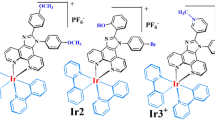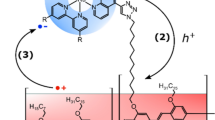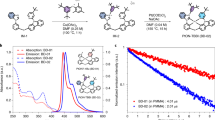Abstract
Research on new materials for organic electroluminescence has recently focused strongly on phosphorescent emitters1,2,3, with the aim of increasing the emission efficiency and stability. Here we report the fabrication of a simple electroluminescent device, based on a semiconducting polymer combined with a phosphorescent complex, that shows fully reversible voltage-dependent switching between green and red light emission. The active material is made of a polyphenylenevinylene (PPV) derivative molecularly doped with a homogeneously dispersed dinuclear ruthenium complex, which fulfils the dual roles of triplet emitter and electron transfer mediator. At forward bias (+4 V), the excited state of the ruthenium compound is populated, and the characteristic red emission of the complex is observed. On reversing the bias (-4 V), the lowest excited singlet state of the polymer host is populated, with subsequent emission of green light. The mechanism for the formation of the excited state of the PPV derivative involves the ruthenium dinuclear complex in a stepwise electron transfer process that finally leads to efficient charge recombination reaction on the polymer.
This is a preview of subscription content, access via your institution
Access options
Subscribe to this journal
Receive 51 print issues and online access
$199.00 per year
only $3.90 per issue
Buy this article
- Purchase on Springer Link
- Instant access to full article PDF
Prices may be subject to local taxes which are calculated during checkout



Similar content being viewed by others
References
Baldo, M. A. et al. Highly efficient phosphorescent emission from organic electroluminescent devices. Nature 395, 151–154 (1998)
Buda, M., Kalyuzhny, G. & Bard, A. J. Thin-film solid-state electroluminescent devices based on tris(2,2′-bipyridine)ruthenium(II) complexes. J. Am. Chem. Soc. 124, 6090–6098 (2002)
Wu, A., Yoo, D., Lee, J.-K. & Rubner, M. F. Solid-state light emitting devices based on the tris-chelated ruthenium(II) complex. 3. High efficiency devices via a layer-by-layer molecular-level blending approach. J. Am. Chem. Soc. 121, 4883–4891 (1999)
Faulkner, L. R. & Bard, A. J. Electroanalytical Chemistry (ed. Bard, A. J.) 1–95 (Marcel Dekker, New York, 1977)
Rudmann, H., Shimada, S. & Rubner, M. F. Solid-state light emitting devices based on the tris-chelated ruthenium(II) complex. 4. High-efficiency light-emitting devices based on derivatives of the tris(2,2′-bipyridyl) ruthenium(II) complex. J. Am. Chem. Soc. 124, 4918–4921 (2002)
Handy, E. S., Pal, A. J. & Rubner, M. F. Solid-state light emitting devices based on the tris-chelated ruthenium(II) complex. 2. Tris(bipyridyl)ruthenium(II) as a high-brightness emitter. J. Am. Chem. Soc. 121, 3525–3528 (1999)
Elliott, C. M., Pichot, F., Bloom, C. J. & Rider, L. S. Highly efficient solid-state electrochemically generated chemiluminescence from ester-substituted trisbipyridineruthenium(II)-based polymers. J. Am. Chem. Soc. 120, 6781–6784 (1998)
Juris, A. et al. Ru(II) polypyridine complexes: photophysics, photochemistry, and chemiluminescence. Coord. Chem. Rev. 84, 85–277 (1988)
Pei, Q., Yu, G., Yang, Y. & Heeger, A. J. Polymer light-emitting electrochemical cells. Science 269, 1086–1088 (1995)
De Cola, L. & Belser, P. Photoinduced energy and electron transfer processes in rigidly bridged dinuclear Ru/Os complexes. Coord. Chem. Rev. 177, 301–346 (1998)
Maness, K. M., Terrill, R. H., Meyer, T. J., Murray, R. W. & Wightman, R. M. Solid-state diode-like chemiluminescence based on serial, immobilized concentration gradients in mixed-valent poly[Ru(vbpy)3](PF6)2 films. J. Am. Chem. Soc. 118, 10609–10616 (1996)
Luttmer, J. D. & Bard, A. J. Electrogenerated chemiluminescence. 38. Emission intensity-time transients in the tris(2,2′-bipyridine)ruthenium(II) system. J. Phys. Chem. 85, 1155–1159 (1981)
deMello, J. C., Tessler, N., Graham, S. C. & Friend, R. H. Ionic space-charge effects in polymer light-emitting diodes. Phys. Rev. B 57, 12951–12963 (1998)
Brédas, J. L., Chance, R. R. & Silbey, R. Comparative theoretical study of the doping of conjugated polymers: polarons in polyacetylene and polyparaphenylene. Phys. Rev. B 26, 5843–5854 (1982)
Berggren, M. et al. Light-emitting diodes with variable colours from polymer blends. Nature 372, 444–446 (1994)
Yang, Y. & Pei, Q. Voltage controlled two colour light-emitting electrochemical cells. Appl. Phys. Lett. 68, 2708–2710 (1996)
Hamaguchi, M. & Yoshino, K. Color-variable electroluminescence from multilayer polymer films. Appl. Phys. Lett. 69, 143–145 (1996)
Tasch, S. & Brandstätter, C. Red-green-blue light emission from a thin film electroluminescence device based on parahexaphenyl. Adv. Mater. 9, 33–36 (1997)
DeCola, L. & Belser, P. Electron Transfer in Chemistry (ed. Balzani, V.) 97–136 (Wiley-VCH, Weinheim, 2001)
Yaliraki, S. N., Kemp, M. & Ratner, M. A. Conductance of molecular wires: influence of molecule-electrode binding. J. Am. Chem. Soc. 121, 3428–3434 (1999)
Pourtois, G., Beljonne, D., Cornil, J., Ratner, M. A. & Brédas, J. L. Photoinduced electron-transfer processes along molecular wires based on phenylenevinylene oligomers: a quantum-chemical insight. J. Am. Chem. Soc. 124, 4436–4447 (2002)
Author information
Authors and Affiliations
Corresponding authors
Ethics declarations
Competing interests
The authors declare that they have no competing financial interests.
Rights and permissions
About this article
Cite this article
Welter, S., Brunner, K., Hofstraat, J. et al. Electroluminescent device with reversible switching between red and green emission. Nature 421, 54–57 (2003). https://doi.org/10.1038/nature01309
Received:
Accepted:
Issue Date:
DOI: https://doi.org/10.1038/nature01309
This article is cited by
-
From species norms to communal metrics: advancing plant community-level historical phenology and phenological ecology
Plant Ecology (2023)
-
Charge-transfer processes in metal complexes enable luminescence and memory functions
Nature Reviews Chemistry (2020)
-
Efficient near infrared light emitting electrochemical cell (NIR-LEEC) based on new binuclear ruthenium phenanthroimidazole exhibiting desired charge carrier dynamics
Scientific Reports (2017)
-
TD-DFT studies on electronic and spectral properties of platinum(II) complexes with phenol and pyridine groups
Chemical Research in Chinese Universities (2013)
-
The Fluorescence and Electroluminescence Properties of the Carbazole–Phenylazomethine Double Layer-Type Dendrimer
Journal of Inorganic and Organometallic Polymers and Materials (2009)
Comments
By submitting a comment you agree to abide by our Terms and Community Guidelines. If you find something abusive or that does not comply with our terms or guidelines please flag it as inappropriate.



